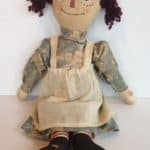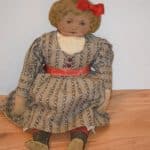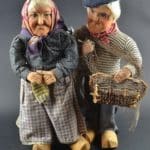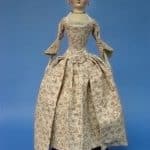Folk Art Dolls
by Jessica Kosinski
It would be impossible to talk about folk art fully without taking some time to recognize a major folk art phenomenon, which was the creation of dolls. While some people might just think of them as children’s toys, older folk art dolls have a lot of historical value and can tell you quite a bit about how people lived at the time that they were made. Not only that, but they can give you glimpses into cultural differences between different groups of people or time periods. Today, many people still make dolls in traditional folk art/primitive styles, but the true early folk art dolls are often some of the most interesting and the most valuable.
Defining Folk Art Dolls:
Interestingly, folk art is a category that can encompass a lot of things. It basically means items that were made by untrained people using non-traditional mediums or individual production instead of mass production in a factory. In terms of American folk art dolls, cloth was often the medium of choice. Also known as rag dolls, they were made by women in their own homes, and generally for their own children to play with, not to sell.
Folk Art Doll Trends in the United States:
Although versions of dolls have existed in many countries for centuries, when most people think of American folk art dolls they think of the 1700s and 1800s. During that time period, there were many different cultures all converging in the United States. Each one brought with it its own traditions, including doll making traditions.
One major example is the rag dolls that were made by African American slaves around the time the Civil War and later. Slave children often played with those caricature dolls, which had features and clothes resembling the men and women in their homes.
The late 1800s brought the introduction of the “Golliwog,” a black character in a series of children’s books created by Florence Kate Upton. The golliwog was depicted as a rag doll with black skin, eyes rimmed in white, clown lips and frizzy hair. Soon homemade golliwog dolls were made and while some were made as women, the original intent was for the doll to be male. Following World War II, the golliwog and the teddy bear were popular stuffed figures thought to be suitable for young boys. Many see this as a cherished cultural icon, while others feel it is a negative form of racism against people of African descent. The doll experienced a second season of popularity in the 1970s in Europe and Australia.
Dolls made in the United States during the start of the 1900s, as well as during the Great Depression and the World Wars that came later, were largely shaped by the times as well. During periods of shortages or wars, materials were scarce. So, many dolls were more simplistic. As times improved, some dolls became more elaborate, and, when factories began mass producing them, traditional folk art dolls faded in popularity for a time.
Almost by definition, since the earliest folk art dolls were produced in homes for people’s own families, there couldn’t be very many popular folk art doll brands in the early days. But by the 1900s doll makers were starting to produce popular lines based on earlier folk art doll styles. One example came about in the early 1900s with the creation of Raggedy Ann & Andy. The first Raggedy Ann stories were published in 1916 by Johnny Gruelle, who based them on a rag doll he found in his attic. Soon after that, Raggedy Ann & Andy dolls started to pop up everywhere. Many of them were homemade by fans of the stories, and are quite unique and valuable. Although, in later years certain Raggedy Ann & Andys were mass produced, and many are still being made to this day.
Other popular U.S. makers of dolls in the folk art style in the 1900s include Halle Blakely, Dorothy Heizer, and Bernard Ravca. Although, Ravca made dolls in France, first. He later permanently moved to the United States after the Nazis took over France. His dolls were prominently displayed at the 1939 World’s Fair in New York City.
Doll Trends Across the Pond:
Of course, dolls were not just made in the United States. England and the surrounding area was one of many that also had its own folk art doll trends in the 1700s and 1800s. Most of their dolls of the time, however, were made of wood, not fabric. They are most commonly referred to as “Queen Anne” dolls, and are generally female. Although, there are some male dolls from the period still in existence.
While rag dolls in the United States often became increasingly elaborate in later years, the wooden dolls of England experienced the reverse. The earliest (and often most collectible) were very elaborate. But quality declined quite a bit by the mid 1800s. Some of the earliest Queen Anne dolls also had fabric upper arms, but many 1800s dolls were completely made of wood instead.
Folk Art Doll Kits and Patterns:
In addition to the finished dolls themselves, some companies released patterns for rag dolls and other folk art-style dolls. There were also full kits sold in some cases that would allow people to make their own dolls. Today, with the popularity of the Internet, many of those older kits and patterns can still be found, and modern doll makers have also come up with their own patterns and kits for today’s doll enthusiasts.
In the early days, folk art dolls were most valuable for what they were, children’s toys. They kept kids busy in times when things like the Internet, video games, and even modern sports did not exist. But today those same traditional folk art dolls are most valuable as either decorative pieces or collector’s items, not to actually play with.
For instance, early Black Americana folk art dolls and other folk art dolls from various cultures and makers regularly sell on websites like eBay for prices ranging from $25 to well over $500, depending on the features of the dolls, their ages, and their conditions. So, if you have a trunk in your attic like the creator of Raggedy Ann & Andy, Johnny Gruelle, you might want to check it. You just might have a small gold mine in the form of an antique folk art doll.
Keep in mind that dolls are still being made today in a multitude of folk art-like styles, including Black Americana style, Raggedy Anne style, and Queen Anne style. So, if you are buying dolls for their collectible value, you will have to learn how to spot the reproductions. Luckily, there are many guides available to help you online and off.
Jessica Kosinski has been a freelance writer specializing in writing short articles for 15 years. She is also an avid collector of both antique books and Star Wars memorabilia. Although she is not in the antiques industry professionally, she has learned a lot about antiques over the years by periodically helping out at her mom’s antiques shop in Greenville, NH. She currently balances maintaining the antiques shop’s Facebook page, www.facebook.com/MallofNE, and working on various freelance writing assignments. She can be reached at dementorskiss77@yahoo.com.











Related posts: